You wouldn’t expect something as simple as opening a can of food to be controversial. Musician and podcaster John Roderick recently had to flee the public spotlight after tweeting about sending his daughter on a six-hour quest to open a can unaided. A Twitter thread went viral after Jean-Michel Connard talked about the foibles of his prepper brother stuck in the dark of Winter Storm Uri, who had canned food but only had an electric can opener.
they can get into the pull top cans just fine, but the ones that require an opener? their only can opener is electric. so a good 3/4 of his canned food store is inaccessible to him unless he goes after it with a knife, which i sincerely hope he does.
— Jean-Michel Connard 좆됐어 (@torriangray) February 16, 2021
Hopefully you have several can openers stashed among your preps, as recommended in the guide to #10 long-term food cans. You can buy military-style P-38 can openers for 50 cents a piece — there’s just no excuse to be without a can opener.
But what if you find yourself without one anyway? There are several methods listed online, some better than others. I decided to review these methods to see which works best in a pinch.
Important bits:
- Have at least one proper opener in your home supplies. A real opener makes this much easier.
- You can open a can with a spoon, but it’s a tedious process and you might break your spoon.
- Another way to open a can is to pierce the lid with the bottom corner of a chef’s knife, but it’s awkward and not as safe as it’s touted to be.
- The best and quickest alternative method is to cut the lid open with a knife. But you’ll dull or damage or blade over time. (Do you know to keep a blade sharp without proper tools?)
- You can open a can by rubbing the lid against a rough surface until you wear away the seal. It works much faster than you might think but could contaminate your food.
- Be safe. I got an eye full of coconut milk while prying a can open for one of these tests. And sharp edges tend to slip when forced.
Narrowing down the methods
There are several methods talked about online, some outright ridiculous, so I first decided to narrow down the possibilities.
The first criteria: no special equipment needed. Sure, you can open cans with tin snips or a bandsaw, but if you have that stuff I’m going to take a wild guess that you’re a fairly handy person already. You can also supposedly open cans with a file, but again, that’s a somewhat specialized tool, not to mention tedious.
The second rule is: nothing absurdly dangerous. Metal cans can be dangerous even with proper tools and lighting, much less if you’re trying to slice the can in half with a butcher knife or open the can with your bare hands. The last thing you want during a stressful time is a laceration that requires stitches and a tetanus shot.
I settled on testing four methods:
- Opening a can with a spoon
- Cutting the lid with a knife
- Using the corner of a chef’s knife
- Rubbing the can against a rough surface
There is no spoon
The spoon method is somewhat unusual, but it seemed to be the safest, since you’re not handling anything sharp. To use a spoon to open a can, you firmly grasp the spoon part and rub the tip against the inner lip of the can lid until you rub through the metal. Then you work the spoon into the opening and move it around the lid until the lid is open.
I struggled with this for several minutes, but eventually rubbed a slit into the can lid. Some videos made it seem like you can then just work the spoon around to split the metal, but I didn’t find this to be true with the Wolf Brand chili I was opening.
I eventually lost patience, got out my pocket knife, and cut the rest of the can open.
The spoon method might be a safe way to get the can started, but it takes a lot of time and will make your hand hurt.
Corner of a chef’s knife
Videos make this seem like such a safe and effective method: you place a large chef’s knife on the top of the can and push the bottom corner into the inner edge of the lid, essentially using it as an old-school can opener.
The first cut went well, but I had trouble positioning the knife for the second cut. What the videos don’t mention is that you’re wielding a large, hopefully sharp knife around against a can that can easily slide around on your counter. Also, it would be very easy for the knife to slip off the can, so if your hand is holding the can in place you could really hurt yourself.
Again, I lost patience and just finished the can with my pocket knife. I wouldn’t recommend this method.
Using a pocket knife
This is the classic “hobo method,” also well-known by pretty much everyone from a developing country. You want a small knife for this, like a pocket knife or a paring knife.
You start the can by placing the tip of the knife on the inner lip of the can, and then you tap the pommel with your other hand to puncture the lid. You then plunge the knife into the can, working the blade along the edge to slice it open.
I was a bit scared of this method, but it works a lot better than I thought it would. You have to be careful with the initial puncture, but it doesn’t take much force to pierce the lid. The knife on my Leatherman Wave also easily cut through the thin metal. Since most of the blade is in the can, there isn’t much danger of it slipping and cutting you. I usually try to move the blade away from my body when cutting, but I found it a lot easier to pull the blade rather than push it, and again, I wasn’t too concerned about slipping.
I would be more concerned about the blade contaminating the food, so you’ll want to clean your knife before doing this. Also, this will dull your knife, so make sure you have the tools and know-how to sharpen it.
Rubbing on a rough surface
The idea behind this method is you run the lid of a can across a rough surface, like a concrete sidewalk until you break the seal. I was hesitant to test this because I figured I would end up spending hours futilely rubbing a can on my sidewalk.
Shockingly, that wasn’t the case. It only took 40 seconds of rubbing before I saw liquid from the can of coconut milk. According to the internet, that’s the point at which you should stop, but looking at the rim of the can, only a slight bit of the seal had been broken and I was afraid I’d have to pull out the pocket knife. So I rubbed a bit more to open more of the can, which didn’t take long.
I then took the can inside to see about prying open the compromised lid. There was one big problem: the can’s rim was coated in concrete grit. The lip was too rough to easily wipe it off, so I cheated a bit and rinsed it with tap water.
It took a little prying with a spoon and then a butter knife, but I managed to open the can without pulling out my pocket knife. Unfortunately, the coconut milk had been contaminated by the grit. That might be acceptable if I were hungry enough, but I decided to toss this can.
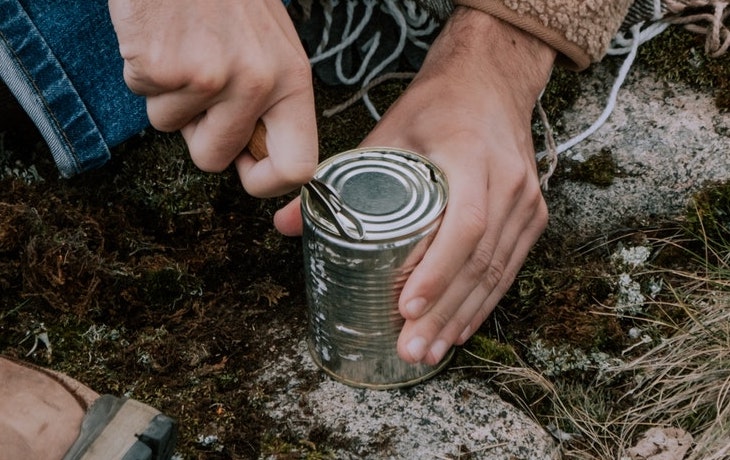

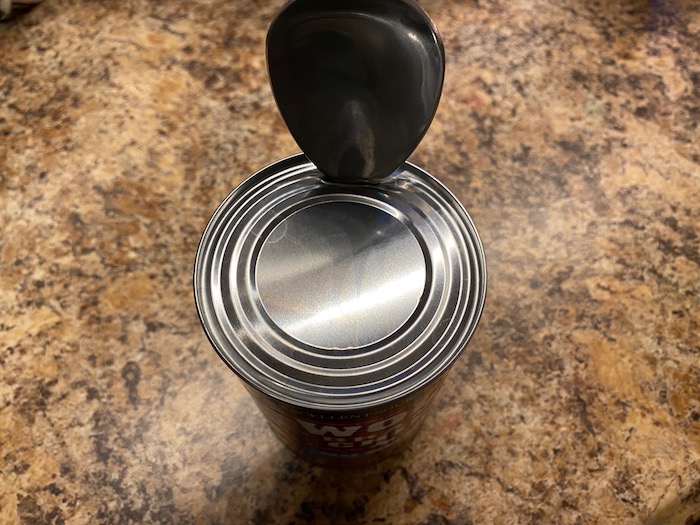
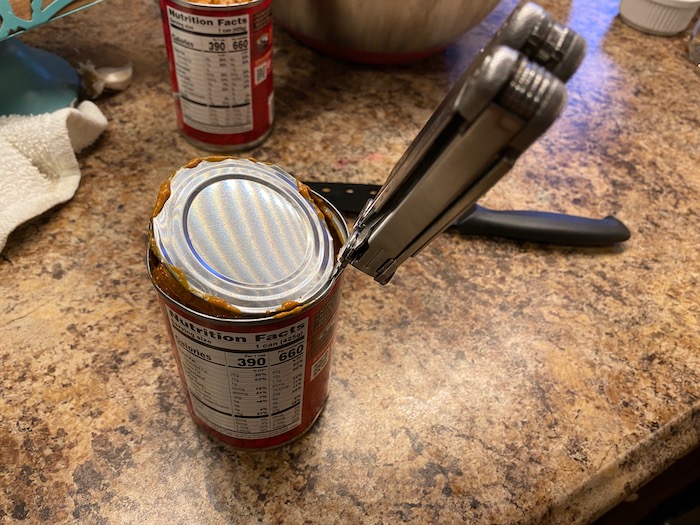
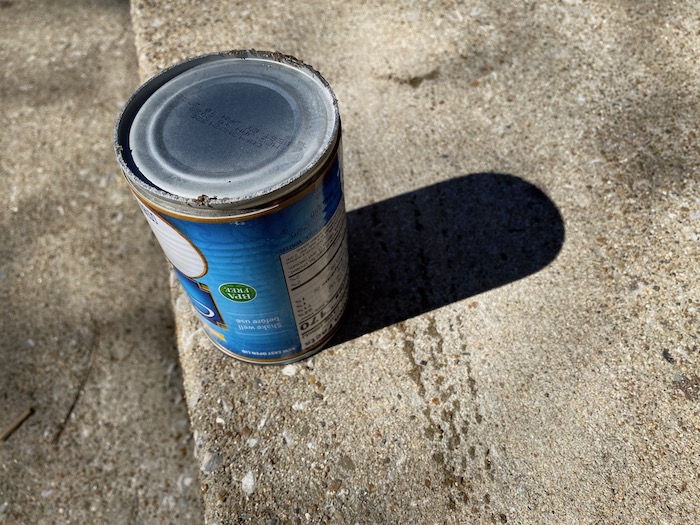
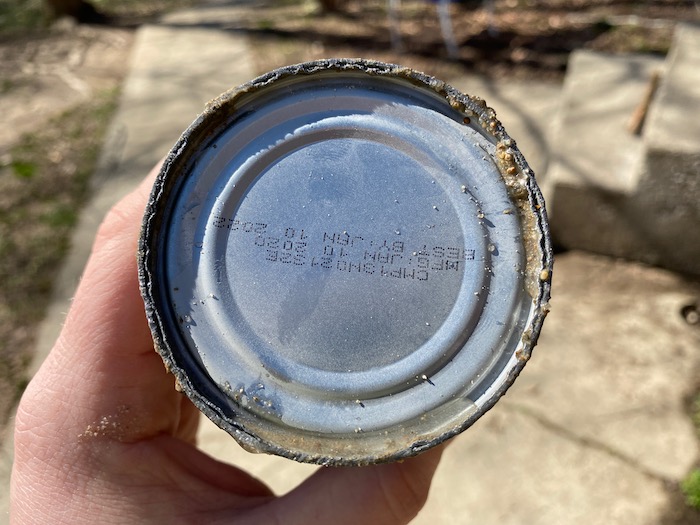
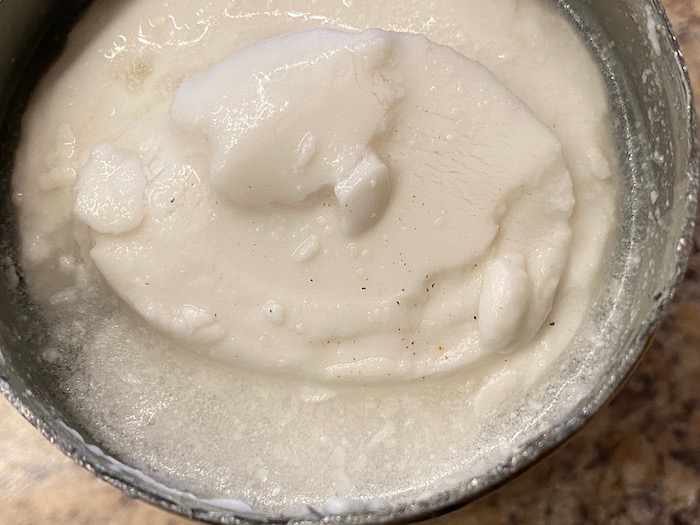
You are reporting the comment """ by on